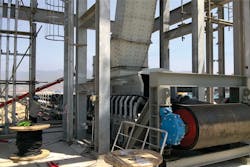Circumvent safety incidents with proper dust control and suppression
Dust generation and emissions are major safety concerns in processing plants and facilities. Dust can cause considerable damage to workers’ health, facilities and the surrounding environment. Too often the damaging effects of dust are underestimated. This is evident in dust control or dust suppression systems that are designed, fabricated and installed only with cost in mind and little attention to detail.
Processing plants can experience considerable losses when little care is given to dust control systems, and a large portion of these losses have been hidden and not directly reported.
Dust consists of particles in the atmosphere that come from various sources of processing activities. Exposure to respirable dusts is high in many processing industries and often exceeds standard and code limits. In other words, the risk of overexposure to dust is high. Recently conducted risk analyses show that dust exposure during a working life, even at levels near the specified international standards, is associated with an increased risk of diseases such as lung cancer. The need for better dust control and dust suppression measures seems obvious. Still, the effectiveness of dust control measures in many industries is not satisfactory.
More should be done to ensure modern system designs exceed specified standards to achieve
excellent, effective and high-performance dust prevention and control. This article discusses modern methods of dust control, dust collection and dust suppression systems for processing plants.
Practical notes
As the first rule, it is better and more cost-effective to prevent dust generation rather than to use expensive and complex dust collection or dust suppression systems to control dust. Therefore, good engineering practices in dust prevention and dust reduction should be followed before the next stage of dust control.
As a rule of thumb, the dust control or suppression system should control airborne emissions generated at each location (such as feeders, conveyors, transfer points, material storage, etc.) to the extent that fugitive emissions from each point is reduced to a low level. As a rough indication, the dust emissions should be below 5 percent of opacity restrictions stated in different international or local standards; emissions should even be kept below 3 percent of opacity restrictions if a superbly clean and healthy working environment is desired. Some older specifications have traditionally specified 10 percent of opacity restrictions (or similar), which is not suitable for modern plants.
A major factor to consider in the design and installation of dust control and suppression systems is the surrounding facility equipment and industrial effects on a system. For example, a system should be designed to support moderate vibration generated from operation of heavy equipment such as large conveyors typically found in processing plants. Otherwise, such a system would be damaged. At the same time, the design, assembly and operation of these systems should not block access for operation or maintenance of other equipment. All the facilities and auxiliaries should be arranged for an overall safe and reliable operation.
Dust collection systems
Dust collection systems work like a vacuum cleaner; they collect dust at dust generation locations using exhaust hoods. The collected dusty air is transferred through specially designed duct work to a dust collector core unit where dust is filtered from the air. The motive force is coming from a fan system, using usually two fans, one operating and another standby. The velocities of dust-laden air and pressure losses through the whole system are two critical points for such a dust collection system. The air velocity at each location should be set to avoid dust settlement. When air travels through the various items such as hoods, ducts, elbows, Y branches, enlargements or contractions (tapers), pressure losses occur. Losses at hoods should be carefully considered because sometimes simplified methods based on a coefficient of entry for the hood is used. In this case, it should be verified that the calculated losses are realistic and correct.
There are different methods to calculate losses in duct work. Pressure loss across duct fittings is usually expressed in terms of equivalent meter of straight duct (of the same diameter) that will produce the same pressure loss as the fitting, although other methods have also been introduced and successfully used. When air travels in a run of duct, pressure losses occur due to the friction between the duct walls and air. There have been different methods for accurately calculating such losses for ducts; however, most of them are based on clean air flow in ducts and not dusty flow. This is a major problem for dust collection systems, and proper coefficients and corrections are needed to compensate this important effect. In addition to pressure losses in the duct work, the losses in the dust collector should also be properly calculated and included. Although the pressure drop for dust collectors varies widely, data are usually available from manufacturers that can be used after some assessments and verifications.
Dust suppression using liquid spray is the most widely used dust control method because it is usually simpler and less expensive.
The exhaust air volume will be determined by the resistance of the available flow paths, and the branch with the least resistance will carry the most volume. As a result, the desired airflow may not be achieved in each branch. This is a major operational issue in many dust collection systems, which is essentially a serious unbalance in air flow. The system should be balanced to ensure desired airflow distribution. In other words, all branches entering a junction should have equal static pressures at the designed flow. There are many methods to achieve this balance; a widely used and cost-effective method is using modern calculation and computerized simulation software to properly arrange and size the duct system and balance flow in branches. Other methods such as using devices like a damper are expensive and sometimes unreliable.
Dust suppression using liquid spray
Dust suppression using liquid spray is the most widely used dust control method because it is usually simpler and less expensive. For any application, the sprayed liquid should be compatible with the service and harmless for the process. Water is the most widely used liquid. However, water cannot be used in some applications due to possible damaging effects to the process, contamination, risk of freezing, different penalties in downstream, reliability issues, quality of final products, etc. On the other hand, a spraying of a small amount of water is acceptable for a wide range of materials and processes; therefore, systems based on water spraying are used in many plants and facilities.
Models and designs for water spraying dust suppression systems vary. Some of them use a combination of compressed air and pressurized water to generate required fine water spraying in terms of size of droplets and their speed and traveling trajectories. Other systems employ a small amount of chemicals to reduce the surface tension of water; it is useful in increasing the number of droplets and achieving required velocities. However, commonly used systems use only pure pressurized water at medium pressures, around 5 to 7 Barg.
The spraying nozzle systems are usually designed on the principle of wetting airborne dust with atomized water (with droplet of waters). As a rough indication, sizes of droplets might be 5 to 50 microns to contain emissions.
Nozzle configurations include fixed-position and adjustable. Adjustable nozzles provide ease of installation, direction adjustment and easy maintenance. A downside, particularly on low-cost models, can be unreliability. On the other hand, if modern simulation tools are used and high performance can be confirmed for all operational situations, fixed-position nozzles are a good option. Water filter assemblies are needed because dirt and debris can damage or plug nozzles. It is generally required to indicate and adjust water pressure to the spray nozzles at each point of spraying.
Some water spraying systems use electrostatically charged water droplets to increase the ability of catching dust and enhance the dust suppression operation. These systems have been used in limited applications because, for many services, they present risk of explosion or sparks. They might be high-performance, in theory, but their complexity and known operational issues limit their use. High associated capital costs, their use of high-voltage equipment and maintenance of electrical insulation make them a less-used option.
Water network for water spraying systems
Many water spraying dust suppression systems do not work properly because of poor design or shortage in their water networks. If the water supplying network is not properly designed and installed, the whole system is set for failure. The first consideration is usually to supply water for a wide range of dust suppression systems and other services such as
wash-down services, cleaning systems and other similar utilities. The required pressure and flow patterns of these services are different; therefore, all of these factors should be considered. The control of pressure for each application and outlet is critical, and appropriate devices such as pressure regulating valves and control valves should be used in appropriate locations.
At each zone, there should be a pressure-reducing valve, pressure-regulating valve or, in a less expensive version, a choking device to adjust the flow and pressure.
For many applications, it is desirable to activate water spraying systems only when the material is flowing — for example, if the belt conveyor is running empty, water sprays should not be on. In such systems, a solenoid-activated valve is usually installed in the water supply line to each spraying point. This measure is necessary to reduce water usage, reduce maintenance and cleanup, and reduce excessive water discharge to materials. Although on/off solenoid valves have been widely used by some manufacturers because of low costs, a smarter option is to use actuated control valves to accomplish both control and on/off functions in a modern system.
The water needed at each location should be properly established for a proper overall piping and water supply system. For example, for a conveyor system with capacity of around 4,000 t/h, the overall water flow might be around 4 m3/h; if overall 10 spraying water points (transfer points) is assumed, the water flow of each water spraying location is around 0.4 m3/h. This is just a rough value; final water requirement should be calculated considering many factors and parameters, and this should be properly optimized and verified in different stages. Obviously, other utility and washing requirements should be added plus some margins to reach overall capacity for the pumping system. The pumping system is usually one operating and another standby.
As another real-world example, the pressure requirement at the dust suppression spraying
location is around 5.5 to 7.5 Barg. Considering differences in elevations, head losses and some margins, the pump discharge pressure might be somewhere between 10 and 14 Barg. For example, for a large processing plant, with many conveyors, transfer points and utility washing services, each pump was sized as 100 m3/h capacity and 12 Barg discharge pressure.
There should be proper control in such a water network to control flow and pressure for each location as a set of large pumps supply water to many users. The system is left for chance if there is no overall and thorough control system. Often a pressure control device, in the form of a pressure-controlling valve, pressure-reducing valve or similar, is needed for each zone or location. Control valves are widely used in such systems to provide superior control and operational flexibility. For many applications, the required pattern of spraying and water flow rates would vary depending on the size and type of materials, the type of machinery and material rates. Therefore, such operational flexibility is a major advantage. It should be possible for the operator to adjust the flow or pressure for the dust suppression operation based on actual observation of the dust emission in each point/location. This is necessary as the water flow (or pressure) should be optimized. Higher water flow than needed is harmful and problematic. Lower flow than required would adversely affect the dust suppression operation. Therefore, proper control devices are needed to adjust the operation. Specifically, the control system should be assessed and verified to make sure all nozzles in many different locations — some close to the pumping system and some far from it, in different elevations — receive the defined pressure and flow they need. In other words, the pressure adjustment on the pump discharge header is needed, but this is not effective to control all zones and locations using an upstream control device because of the pressure drop between different zones and locations.
A solution might be to provide high-pressure water to all zones/locations. At each zone, there should be a pressure-reducing valve, pressure-regulating valve or, in a less expensive version, a choking device to adjust the flow and pressure. There have been water networks for dust suppression systems that used orifice to choke the flow and provide some level of control for each zone. This is not usually recommended because it only provides basic, rough or often poor control. However, some contractors still use such a system to save money. If used, a larger and a smaller orifice size should be provided (as spares in hand) to allow the operator to replace any orifice in each location to provide some adjustment of flow/pressure. This can be easily done in a short shutdown, and it offers some flexibility in operation. In an even less expensive version of the above-mentioned system, a choke tube, i.e., an undersized piece of pipe to choke the flow, is provided. Such a system may even work if the system is designed properly with extensive simulations and calculations. However, the level of control and performance is often poor and there is no flexibility — it is extremely difficult to change the choke tube, which is essentially an undersized section of piping (it needs cutting, welding, etc). Therefore, if such a system is used, it is absolutely necessary to provide all calculations and details on operation and system behavior in different scenarios. This is not just a simple hydraulic calculation, for instance, to size pumps. All details for different scenarios of operation should be investigated and evaluated.
Amin Almasi is a senior rotating machinery consultant in Australia. He is a chartered professional engineer of Engineers Australia and IMechE and holds bachelor’s and master’s degrees in mechanical engineering and RPEQ. He is an active member of Engineers Australia, IMechE, ASME and SPE and has authored more than 100 papers and articles dealing with rotating equipment, condition monitoring, offshore, subsea and reliability.



